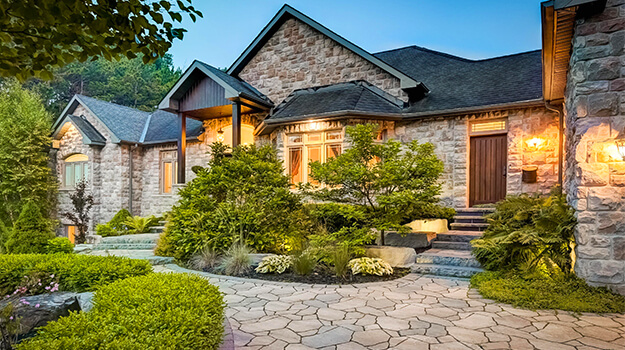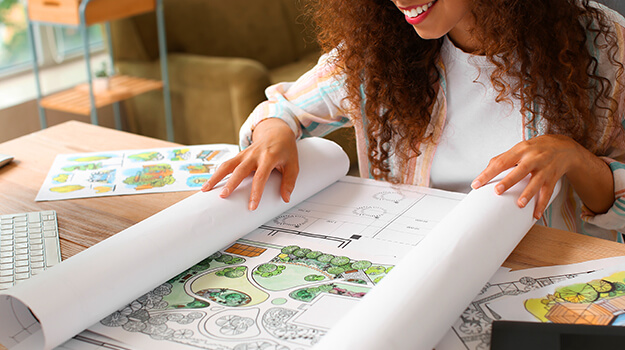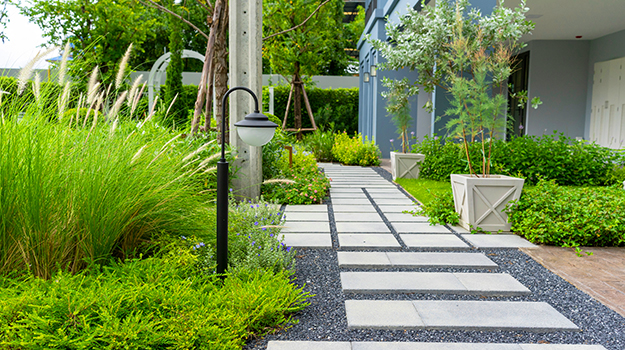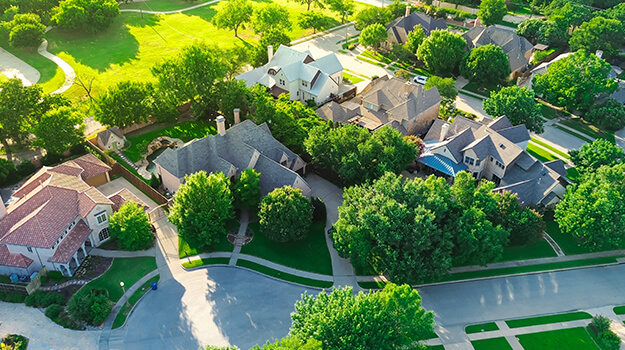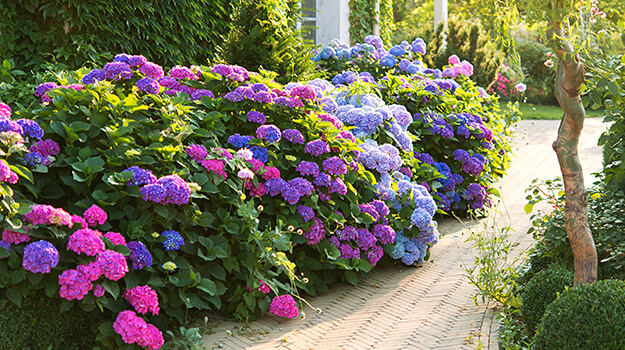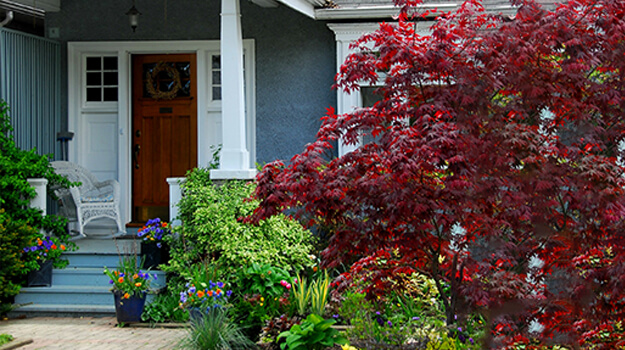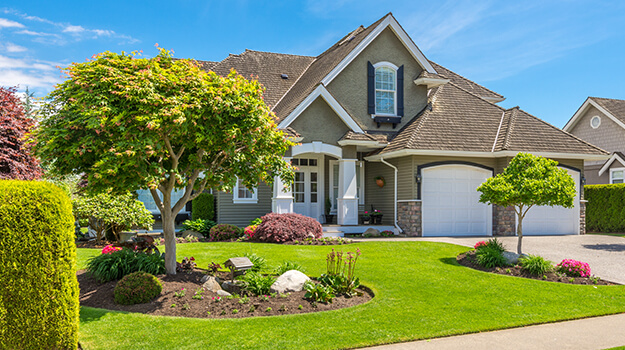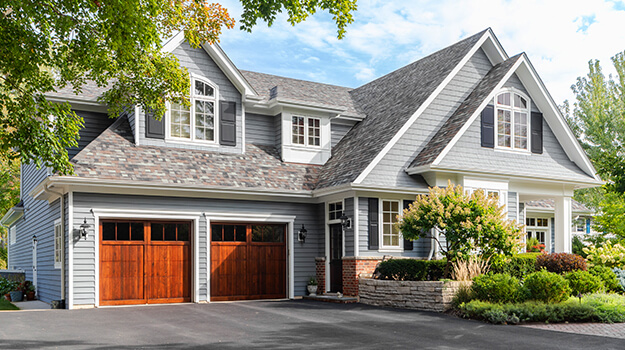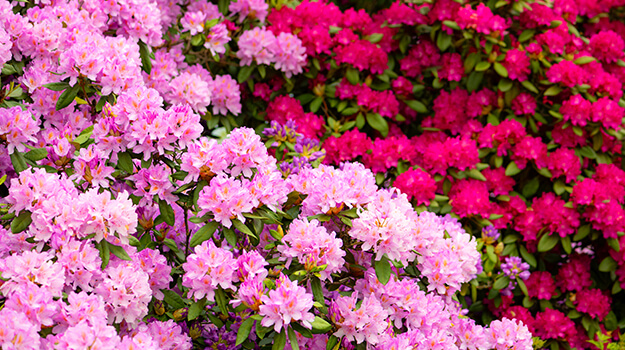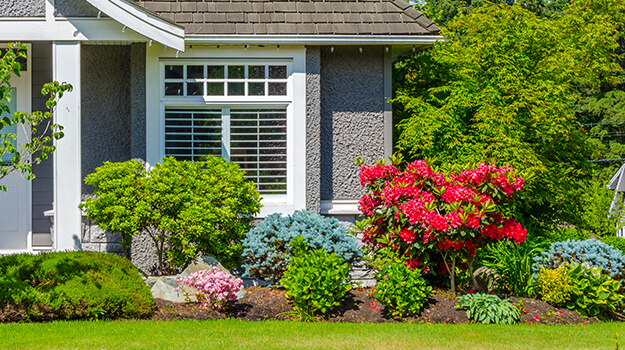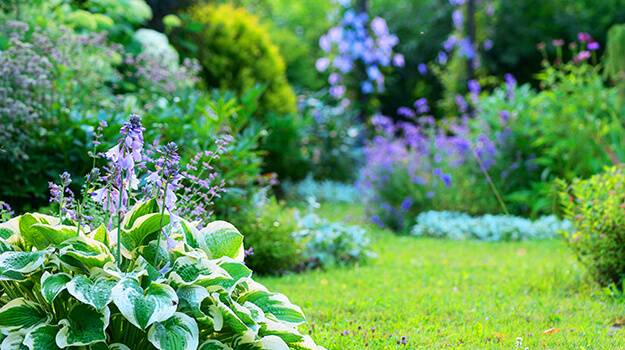- Landscaping: a sure shot!
- How to plan sustainable landscaping
- What is the architectural style of the house
- What to preserve from the previous landscaping
- Planning circulation areas
- Which plants to put in front
- Where to plant trees
- How to use shrubs
- How to mark the limits of your front yard
- How to arrange feature plants in a front yard
- How to create shrub and flower beds
- Too many plants is like not enough
- How to use colour in the front yard
You have transformed your backyard into a little oasis… You maintain it with care… perhaps to the detriment of your landscaping at the front of the house?
If you've been hiding a spectacular backyard behind a dull façade, now's the time to do something about it. But where to start? In what order should you proceed?
Don't leave anything to chance. Proper planning is the key to a successful landscaping. Drawing out your plan will allow you to clearly visualize and make adjustments before breaking ground. Benefit from our advice and find inspiration in our landscaping plans!
Don't forget to download our front yard landscaping plans. You'll also find beautiful plant suggestions for continuous flowering: Front yard landscaping plans
Landscaping: a sure shot!
The front yard of your home creates the first impression. A well-maintained lawn and well-landscaped yard are the first things your visitors will see... and the only view passersby have access to.
Improving your front yard can increase the value of your property at a relatively low cost. In the real estate business, the return on investment can be as high as 217%.
How to make a sustainable landscaping plan
Front yard landscaping isn’t something you do regularly. Your plan should therefore take your current and future needs into account. Ask yourself the following questions before you begin.
- How many parking spaces are needed? Got teenagers? It's best to plan for space for their cars... or a motorhome for later!
- Should you mark the boundaries of your front yard with a fence or hedge? You get along great with your current neighbours, but if they were to move...
- How much grass should you keep? Lawnless front yards are increasingly popular, but it's best to do it gradually as this type of landscaping represents a considerable investment... of time and money!
- Is your landscaping safe and functional? How do you access the yard? What type of lighting should you choose and, if necessary, how can you hide the wiring? Adding stepping stones makes it easier to maintain a large flower bed, a ditch that's difficult to mow could be transformed into an alpine garden, etc.
- How much time do you wish to spend on maintenance? For some, weeding is relaxing, for others, it’s a tedious chore…
- Dreaming of having a pool, spa or pond in the backyard? If so, you'll need to leave some space on the side of the house for heavy equipment. Perennials and grasses are easier to move than trees or hedges!
- What to do with slopes? A grassy slope in full sun may require more maintenance than an alpine garden.
- Does water tend to accumulate in certain spots? This is an opportunity to fix slopes and fill depressions to channel water from gutters or your neighbour’s yard. Move it away from your foundation to prevent disasters!
- Do you know what the municipal regulations are? Each municipality has its own regulations regarding fence heights, parking sizes, and more. Most also require a permit.
What is the architectural style of the house?
In landscaping, the possibilities are almost endless. However, to avoid stylistic errors, harmonize the concept with the architectural style of your house, which is the basic element around which the garden is organized. After all, the primary goal of front yard landscaping is to enhance it!
Choosing between a formal or informal style for your landscaping
Your landscaping can be formal or informal. Landscape architects will tell you that it's not only a matter of taste, but also of style.
A formal garden features strong geometric lines, carefully trimmed hedges, and uniform plants and flower beds. A modern-style home will generally be enhanced by a minimalist garden with clean, straight lines.
The informal style features flowing, natural-looking shapes, curves, informal hedges and less rigid plants. For example, an English garden will enhance a Victorian or country-style house, a vacation home or a New England style.
Generally, sloping yards require less rigid landscapes, while flat yards are enhanced by formal or informal landscaping.
That being said, keep in mind that you’re doing all this for yourself, so have fun creating something unique that resembles you.
What should you keep of the old landscaping?
If it is not a new house, sort the existing elements: those you want to keep, those you want to modify and those that will be eliminated.
Keeping certain structural elements (paths, stairs, arbours, etc.) will save you time, money and energy. A spectacular flower border can divert attention from a path with unattractive but still perfectly level flagstones!
Unless they're diseased or planted too close to buildings or electrical wires, keep mature trees and shrubs and build around them. With mature plants, your landscaping will look stunning the first year. It’ll take a lot more time if you start over with small trees and shrubs.
An old shrub can regain its former appeal in no time with a little rejuvenation pruning. Don't hesitate to dig up perennials, divide them and relocate them. It’s an economical way to create a decor that meets your expectations.
Planning circulation spaces
Show the way! The goal of front yard landscaping is to create a sensory experience that welcomes visitors to your place.
First, determine the location and dimensions of the circulation spaces and driveway. You’ll need to create two distinctive pathways. The first, leading to the main entrance, should be at least 1.20 m wide. The second connects the driveway to the backyard. The recommended minimum width is 90 cm.
Professionals recommend avoiding contact between two different inert materials (e.g., house foundation and paved pathways). Consider bordering pathways with attractive flower beds!
Lawns can play a similar role, but they are more sensitive to repeated trampling. In high-traffic areas, if you don't want cement or paving, consider decorative rocks, gravel, stepping stones, or even thyme in sunny areas!
TIPS
When the time comes to draw your plan, use your location plan to trace the outline of your house, driveway, hedges and other existing features.
Which plants to use at the front of the house
A well-planned landscaping can offer a stunning spectacle 12 months a year! Depending on the choice of plants, the same front yard can feature exclusively white blooms in spring, showcase a beautiful blend of purple, mauve and fuchsia all summer, and then switch to orange, copper and bronze tones in the fall. As a grand finale, the branches and red berries will contrast beautifully with the whiteness of the snow.
Use plants with different foliage colours and choose flower colours that go well together, making sure there’s always something blooming. You’ll need at least one tree (if your yard is small, opt for a small tree or a pyramid shape), shrubs, perennials and annuals. Conifers have the advantage of being attractive year-round (unless you choose a variety or location that requires protection in winter!).
Consider the habit and structure of your plants to ensure they remain attractive once the leaves have disappeared. Avoid plants whose foliage is slow to appear in spring and that will look dead when everything else starts to bloom.
PRO TIP
When choosing your plants, check their hardiness zone. Also, make sure the location you choose is suitable for their needs in terms of soil, light, etc. Your plants will perform at their best, require less care... and survive!
Where to plant your front yard trees
The location of trees (and large shrubs) must be carefully considered. Planted in the wrong spots, large plants quickly swallow up windows, block walkways and threaten foundations and power lines.
To avoid problems and useless expenses, plant trees so that they surround your house. If you have enough space, create an interesting asymmetrical balance by planting a tree on each side, varying the species (conifers and deciduous trees, foliage colours, sizes, etc.) and placing them at a different distance from the street.
Be careful with balance! Very large trees planted in the front yard of a bungalow will make the house appear smaller. It's better to opt for medium-sized trees. Reserve large trees for the backyard, where they will accentuate the sense of depth and provide a beautiful backdrop for the house.
How to use shrubs in the front yard
Plants planted near the house create the backdrop. Deciduous trees, such as small or medium-sized conifers, are an interesting choice for structuring the decor. Care should be taken to space them sufficiently away from the building so they can grow well and air can circulate. Be careful not to block the front door. For added privacy, plant a delicate shrub a few metres from the entrance.
As a general rule, shrubs with light foliage stand out better against dark siding, and vice versa.
Choose plants whose mature size is perfectly suited to the chosen location. This will prevent you from engaging in a battle against nature that requires annual pruning, often with disappointing results. Moreover, some plants, such as boxwood, tolerate pruning well, while others, such as Van Houtte spirea, are at their best when you only prune old or damaged branches.
How to mark the limits of your front yard
Whether it's to create privacy, hide an unwanted view, break the wind or for any other reason, a division made of plants is an interesting and also economical option compared to a fence!
Don't limit yourself to the traditional cedar hedge. A low hedge (rose bushes, barberry bushes) is enough to discourage intruders. A hedge made of grasses creates a psychological barrier without making you feel confined. An informal hedge (Van Houtte spirea) offers a less rigid visual division, perfect for ensuring privacy in the backyard. In fact, several large shrubs can create spectacular hedges. Mixed hedges are increasingly popular!
Also consider tall perennials: goat's beard, aralia, baptisia, eupatorium, white dragon knotweed (not Japanese knotweed, which is invasive!), perennial hibiscus, rodgersia. They offer beautiful blooms and look like shrubs, but have the advantage of disappearing entirely at the end of the season, which protects them from winter damage.
How to arrange feature plants in a front yard
In every landscaping, there are feature plants. These are the cornerstones around which other plants are arranged. Front yard landscaping is unique in that it aims to showcase the house. It's the central element... and it should remain so! Therefore, don’t create more than one point of interest to avoid competing with it and ending up with an arrangement that’s overloaded.
How to create shrub and flower beds
You've drawn your flowerbeds on paper, now it's time to create them full-scale. A half-moon edger and a garden hose will make this task easier.
Thanks to its flexibility, the hose allows you to trace any flower bed shape on the ground and modify its curves and dimensions at will without damaging the lawn. Once satisfied, simply cut the lawn using the edger and following the hose.
Here are a few tips to have a flowery front yard throughout the season:
- Plant annuals of various sizes, not just along the edges, but also in the centre and at the back of flower beds. Our favourite: Verbena bonariensis.
- Add a few reblooming or continuous blooming shrubs. Japanese spirea from the Double Play series, lilac Boomerang and hydrangeas Endless Summer are great options.
- Hide early bulbs under perennials that are slow to appear in spring. They will fill in the bare spaces for as long as necessary. Hostas, which are slow to wake up, are perfect for hiding the wilting foliage of tulips!
- Keep a place at the back of the flower bed for large plants with spectacular flowers but unattractive foliage, such as phlox, which is prone to mildew, asters, irises and bleeding hearts, whose foliage withers quickly.
- Respect the recommended spacings between plants. To temporarily fill bare spaces, plant annuals or ground covers. Choose easy varieties like creeping phlox rather than species that are difficult to control. Otherwise, a good layer of mulch will prevent weeds from settling in!
How big should a flower bed be? It all depends on its location (along a path or foundation, at the edge of the yard, etc.). It's also a question of proportion. The longer the flower bed, the wider it should be.
Too many plants is like not enough
Planting too densely for a quick effect will sooner or later become a maintenance nightmare. Your plants will also be more at risk of disease, not to mention the chaotic appearance it will create.
On the other hand, sparse landscaping is neither aesthetically nor environmentally satisfactory. Layering and juxtaposition create vibrant, rich landscapes, both visually and biologically, that attract birds, pollinators and other beneficial insects to the garden... Even better, it makes it harder for weeds to settle in, and plants are more resistant to drought.
Respect the recommended spacings between plants. If you're not patient, buy larger plants... It doesn't cost more than spending on three small plants to fill a space that was actually enough for one!
BE CAREFUL! A dwarf plant can reach 20 feet in height, so take the time to do your research. For example, the size indicated on a conifer's label is often based on its estimated height in its tenth year... it's not necessarily finished growing! No label mentions that a 100-year-old oak can have a diameter of 1.5 m.
How to use colour in the front yard
Plants with colourful foliage create superb points of interest, but should be used sparingly. In fact, vibrant flower beds are best suited to the backyard, where they don't have to compete with the colours of the siding, the cars, etc.
You can avoid chaos by limiting the number of colours and using different proportions for each. The colours of your plants can match those of your house or create a beautiful contrast.
Read our article to learn all about using colour in the garden: How to arrange flower colors in the garden?
TIP
Choose plants that will be visible from a distance and plant them in a cluster so the eye is not tired out by a multitude of small spots of colour.

